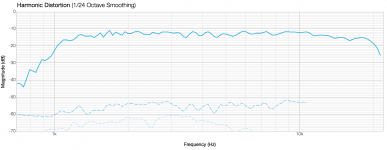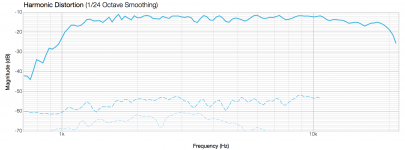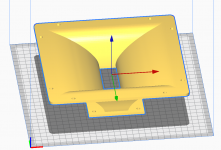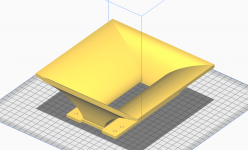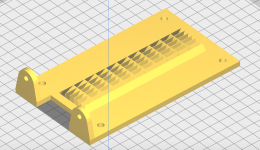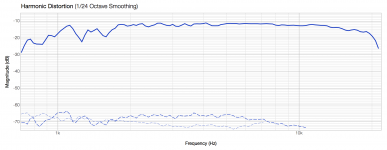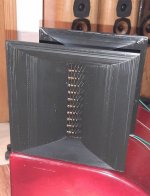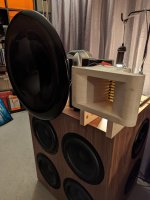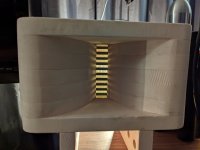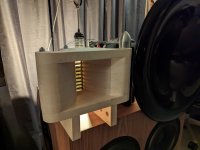Not too dissimilar from my measurement. This means that filter, original horn in front and large closed box behind is the best loading of this transducer. I was lucky to try that first, but I also gave it a thought (and there is my bias against dipoles for anything except bass)
The horn on both sides look better IMHO.
The horn on both sides look better IMHO.
Above 2khz yes but you lose a lot between 1khz and 2khz.
Above 2khz yes but you lose a lot between 1khz and 2khz.
How low do you cross it?
This is the response of my horn with the back cover that I designed. Similar to open from behind.
View attachment 989774
View attachment 989773
Thanks for sharing this. I see your measurement also displays the trough past 2.5 and 7kHz. Mine was centered around 6kHz and yours is around 4.5kHz, so not exactly the same but directionally the same.
By the way, are your measurements indoors & gated?
Your measurement of the double horn & double filter looks great! +/-1dB from about 1.8 to 12kHz. I see you also measure the 4dB drop at 15kHz.
Your last posted measurement shows your horn and filter open back, showing +/-2.5dB from about 1.6kHz to 13kHz. Yours is flatter than my Beyma horn with your filter, but the Beyma is +/-3dB...not bad.
Congrats on your great work!!
I'm going to start posting the STLs.
There are 3 optimal options.
First: The original Beyma horn with TPL-filter. The rear part with a large chamber, similar in dimensions to the trumpet. An enclosure measuring 23 x 23 x 23 cm or larger. This can be valid for active speakers with a 6.8 uF capacitor in series to protect the tuiter.
The distortion values are not valid to compare the different options because they are made at different power and gain of the sound card.
This is the STL of the TPL-150 filter.
There are 3 optimal options.
First: The original Beyma horn with TPL-filter. The rear part with a large chamber, similar in dimensions to the trumpet. An enclosure measuring 23 x 23 x 23 cm or larger. This can be valid for active speakers with a 6.8 uF capacitor in series to protect the tuiter.
The distortion values are not valid to compare the different options because they are made at different power and gain of the sound card.
This is the STL of the TPL-150 filter.
Attachments
The tractrix of the same size as Beyma horn 23 x 23 cm, with less coloration than Beyma horn, in the same enclosure. This does not need a capacitor for the response to be flat. Is valid for passive filter or active loudspeaker without capacitor.
With the same TPL-150-filter. Complicated to print because it is 23 x 23 cm.
With the same TPL-150-filter. Complicated to print because it is 23 x 23 cm.
Attachments
Tractrix to place above the speakers. It can be big 18 cm or small 16 cm. They are similar. but if you want to cut at 1000Hz, Big is better. These are the TPL-150-Rear filters because they allow the terminals to be left free. And allows to hold the speaker.
If you want a flat response up to 1000 Hz just add a 23 x 23 cm wooden frame for example (Better more 30 x 23....). That comes from the beginning of the front horn to the end of the rear horn.
Let's see if I have time to make that extruded polystyrene frame and set minimum frame measurements and its flat frequency response. I hope to put it in about 2 weeks.
If you want a flat response up to 1000 Hz just add a 23 x 23 cm wooden frame for example (Better more 30 x 23....). That comes from the beginning of the front horn to the end of the rear horn.
Let's see if I have time to make that extruded polystyrene frame and set minimum frame measurements and its flat frequency response. I hope to put it in about 2 weeks.
Attachments
Last edited:
And the images that have not appeared in the previous post.
Attachments
Luis, I would like to thank you for the amazing hard work you have put into improving this exciting tweeter and so generously have shared with the DIYA community. Absolutely precious and exemplary attitude.
I have installed the filters on two of my tweeters and will do so on the other two now naked TPLs once I have horns for them, most likely the largest of your tractrix “trumpets” to try out 🙂
It would be very interesting to see you design an even larger horn or WG for the TPL to support these lower crossover points, i.e. something on the order of 35-40 cm tall and wide. Is this something you could take an interest in doing?
I have installed the filters on two of my tweeters and will do so on the other two now naked TPLs once I have horns for them, most likely the largest of your tractrix “trumpets” to try out 🙂
It can be cut at 1400 Hz. Even 1000 Hz and without steep slope. This speaker does not squeak. It does not respond to 800 Hz but it also does not have harmonic distortion at 800 Hz. Since it does not excursion outside the magnetic field like a conventional membrane.
It would be very interesting to see you design an even larger horn or WG for the TPL to support these lower crossover points, i.e. something on the order of 35-40 cm tall and wide. Is this something you could take an interest in doing?
The designed horn does not allow to make a major trumpet. You can get response from this speaker at 600 Hz. But it will have a peak response at 1000 and 2000. If the Tractrix profile is made but larger and deep, 40 cm, the response is no longer flat, an even greater gain is produced at 2000, 1000 Hz, etc. same as the Beyma horn. It may interest someone who wants to work active speakers, at the cost of greater directivity. But not viable for pasive speakers.
If you want flat response down to 1000 Hz. It is simply to build a larger 40cm front panel glued to edge horn . But the horn with same depth. You will get a lovely flat response down to 1000Hz. And you will see signal at 800 and 600 but lower level. And if you intend to amplify in active so that it is flat at 600 Hz. the distortion will also increase.
If you want, I can make a 40 cm horn to be tested, half with the printer and half with extruded polystyrene. Although for my passive speakers design, and time alignment with the bass, it does not work for me. Not for passive. Just to test the limits of this speaker.
If you want flat response down to 1000 Hz. It is simply to build a larger 40cm front panel glued to edge horn . But the horn with same depth. You will get a lovely flat response down to 1000Hz. And you will see signal at 800 and 600 but lower level. And if you intend to amplify in active so that it is flat at 600 Hz. the distortion will also increase.
If you want, I can make a 40 cm horn to be tested, half with the printer and half with extruded polystyrene. Although for my passive speakers design, and time alignment with the bass, it does not work for me. Not for passive. Just to test the limits of this speaker.
It would be very interesting indeed to see how far down the TPL-150 could practically be pushed in a much larger 40cm horn for domestic use, even if primarily just for active applications, which I’d assume many on here are doing anyway including myself. With accompanying distortion measurements (at spirited levels), it would also demonstrate (or not) what you said about the TPL having useful output at 800Hz without sounding poorly (squeaking or distortion). Half printed, half polystyrene should be sufficient for proof of concept. Wider directivity would save on material as would perhaps a rectangular horn (e.g. 90x75 or 80x65 or 100x85)
Luis,
I can't thank you enough for this!
Just to make sure: the optimal open back config would include the front filter and tractrix 23x23cm from post #67 and the back horn and filter from post #68. Correct?
Does the front horn feel strong enough to attach to a front baffle and have the rest of the assembly "hang" from the front horn? This is how I'm doing with the Beyma waveguide.
I can't thank you enough for this!
Just to make sure: the optimal open back config would include the front filter and tractrix 23x23cm from post #67 and the back horn and filter from post #68. Correct?
Does the front horn feel strong enough to attach to a front baffle and have the rest of the assembly "hang" from the front horn? This is how I'm doing with the Beyma waveguide.
There were some measurements somewhere showing resonances below 2k for the TPL150 but I wonder if these are not audible since many are crossing much lower?
They are not resonances below 2 Khz. They are cancellations. The resonances are when the energy accumulates and is returned prolonging the duration of the response in time, it is audible and annoying. This is not the case.
This case is cancellations because the horn is on top of the speaker and the horn is short for 1000 Hz. Cancellations are not audible. But if you don't want to have those wave cancellations below 2KHz, the tompet should be placed inside the speaker rather than on top. Or if it is on top, you have to put a panel that makes the surface of the trumpet larger, for example 34 cm wide, good for 1000 Hz.
This weekend I will put a panel, take photos and put the measurements. So that you can understand me.
auto_awesome
LewinskiH01 I think it will be strong enough with my printer and my material. But it depends on the printing at what temperature it is made and the type of material. Perhaps in your case you have to reinforce with wedges and glue. Do not know. And in your case you can perfectly use the 23 x 23 horn in front and any of the others behind as it says. No problem. They are all compatible with each other.
This case is cancellations because the horn is on top of the speaker and the horn is short for 1000 Hz. Cancellations are not audible. But if you don't want to have those wave cancellations below 2KHz, the tompet should be placed inside the speaker rather than on top. Or if it is on top, you have to put a panel that makes the surface of the trumpet larger, for example 34 cm wide, good for 1000 Hz.
This weekend I will put a panel, take photos and put the measurements. So that you can understand me.
auto_awesome
LewinskiH01 I think it will be strong enough with my printer and my material. But it depends on the printing at what temperature it is made and the type of material. Perhaps in your case you have to reinforce with wedges and glue. Do not know. And in your case you can perfectly use the 23 x 23 horn in front and any of the others behind as it says. No problem. They are all compatible with each other.
Thanks Oneoclock. The problem I have had with TPL150H is sibilance around 8K. A notch at this frequency helps but I would like to have a proper solution for this.
I have used the tpl-150 in horns for some times in the past and around a year ago switched to compression drivers because there was something bothering me with the TPL. I don't think it's the 8khz peak by itself considering I get rid of it in my active crossover/eq (deqx).
This weekend I reinstalled the tweeters temporarily and tried to find a solution and it brought me to this thread. That acoustic filter caught my attention.
My main concern have been a slight peak of high frequency directly in the axe and a sharp decline when moving couple inches from the sweet spot. This would change the presentation and tonal balance slightly when moving and annoyed me over time. I recently fixed part of the problem removing the back charge (I had symmetrical horns front and back in dipole configuration) while moving the tweeters back from the wall. Removing the rear horns helped a lot, I should had tried this before. Now I have the back open shooting to the rear wall where there is some absorption, seems to work better than absorbing the back wave close to the tweeter.
The other concerns are more about a small feeling of compression compared my compression drivers, the lower efficacy compared to my usual 113db may simply be the cause of that.
I still really like the relaxed and aerial presentation of the TPL with horns and would be interested in finding a solution for the tonal shift when moving from the sweet spot.
Would you say that using those lenses reduced the directivity of the 8-10khz and up a little bit ? when using or not using the acoustic filters, do you get more constant tonal balance when moving from direct axis to off axis, kind of a switch in balance while moving your head left to right ?
I have a hard time describing it, it's not a phasing problem but it's similar to the feeling I had using large electrostatic speakers like my acoustats or quad esl-57. My esl-63 didn't do that, the 57 did it a little and the acoustats were horrible in that aspect. I feel a little bit the same with the tpl-150. I don't remember having this feeling with my great Heil.
My test horns have JMLC expansion and are maybe a little big for the crossover point I'm using. I normally switch from my mid horn, to the tweeters at around 3khz. With the TPL I go as low as 1.8khz without problems, they don't have the energy of my mid horns but do quite well that low.
Based on your experience with the acoustic filters I could be tempted to try it and maybe find a way to return the TPL in my system.
This weekend I reinstalled the tweeters temporarily and tried to find a solution and it brought me to this thread. That acoustic filter caught my attention.
My main concern have been a slight peak of high frequency directly in the axe and a sharp decline when moving couple inches from the sweet spot. This would change the presentation and tonal balance slightly when moving and annoyed me over time. I recently fixed part of the problem removing the back charge (I had symmetrical horns front and back in dipole configuration) while moving the tweeters back from the wall. Removing the rear horns helped a lot, I should had tried this before. Now I have the back open shooting to the rear wall where there is some absorption, seems to work better than absorbing the back wave close to the tweeter.
The other concerns are more about a small feeling of compression compared my compression drivers, the lower efficacy compared to my usual 113db may simply be the cause of that.
I still really like the relaxed and aerial presentation of the TPL with horns and would be interested in finding a solution for the tonal shift when moving from the sweet spot.
Would you say that using those lenses reduced the directivity of the 8-10khz and up a little bit ? when using or not using the acoustic filters, do you get more constant tonal balance when moving from direct axis to off axis, kind of a switch in balance while moving your head left to right ?
I have a hard time describing it, it's not a phasing problem but it's similar to the feeling I had using large electrostatic speakers like my acoustats or quad esl-57. My esl-63 didn't do that, the 57 did it a little and the acoustats were horrible in that aspect. I feel a little bit the same with the tpl-150. I don't remember having this feeling with my great Heil.
My test horns have JMLC expansion and are maybe a little big for the crossover point I'm using. I normally switch from my mid horn, to the tweeters at around 3khz. With the TPL I go as low as 1.8khz without problems, they don't have the energy of my mid horns but do quite well that low.
Based on your experience with the acoustic filters I could be tempted to try it and maybe find a way to return the TPL in my system.
Attachments
Hello Frank.
I have not found any directivity and side lobe problems horizontally +- 15 degrees. But if it has directivity and lobes when it loses 20 or more degrees vertically.
In photos of your speakers I see that perhaps your TPL points a little low. Simply pointing 10 degrees up would improve.
In my opinion the biggest problem with your trumpet is not making an exponential curve vertically. That will cause problems at 10 degrees or less.
I would recommend an exponential lowering of the wood (2 cm.) at the top and bottom, plus a tilt of the speaker, or a slightly higher position.
If you want, I have several more trumpets that I have tested with and I am going to throw away. I can send for you to test as long as you pay the shipping costs which can be around € 10-15. I would be interested to see your result whit this.
I have not found any directivity and side lobe problems horizontally +- 15 degrees. But if it has directivity and lobes when it loses 20 or more degrees vertically.
In photos of your speakers I see that perhaps your TPL points a little low. Simply pointing 10 degrees up would improve.
In my opinion the biggest problem with your trumpet is not making an exponential curve vertically. That will cause problems at 10 degrees or less.
I would recommend an exponential lowering of the wood (2 cm.) at the top and bottom, plus a tilt of the speaker, or a slightly higher position.
If you want, I have several more trumpets that I have tested with and I am going to throw away. I can send for you to test as long as you pay the shipping costs which can be around € 10-15. I would be interested to see your result whit this.
I think that's what this thread is about.Thanks Oneoclock. The problem I have had with TPL150H is sibilance around 8K. A notch at this frequency helps but I would like to have a proper solution for this.
Hi Oneclock,Hello Frank.
I have not found any directivity and side lobe problems horizontally +- 15 degrees. But if it has directivity and lobes when it loses 20 or more degrees vertically.
In photos of your speakers I see that perhaps your TPL points a little low. Simply pointing 10 degrees up would improve.
In my opinion the biggest problem with your trumpet is not making an exponential curve vertically. That will cause problems at 10 degrees or less.
I would recommend an exponential lowering of the wood (2 cm.) at the top and bottom, plus a tilt of the speaker, or a slightly higher position.
If you want, I have several more trumpets that I have tested with and I am going to throw away. I can send for you to test as long as you pay the shipping costs which can be around € 10-15. I would be interested to see your result whit this.
I forgot to let you know that I answered by messaging/conversation but I'm not sure if it worked since I'm not used to the new interface. Let me know if you can't find it.
- Home
- Loudspeakers
- Multi-Way
- Acoustical notch filter for TPL-150
